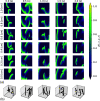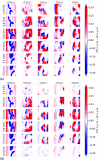Robust data assimilation with noise: Applications to cardiac dynamics
- PMID: 33754752
- PMCID: PMC7796825
- DOI: 10.1063/5.0033539
Robust data assimilation with noise: Applications to cardiac dynamics
Abstract
Reconstructions of excitation patterns in cardiac tissue must contend with uncertainties due to model error, observation error, and hidden state variables. The accuracy of these state reconstructions may be improved by efforts to account for each of these sources of uncertainty, in particular, through the incorporation of uncertainty in model specification and model dynamics. To this end, we introduce stochastic modeling methods in the context of ensemble-based data assimilation and state reconstruction for cardiac dynamics in one- and three-dimensional cardiac systems. We propose two classes of methods, one following the canonical stochastic differential equation formalism, and another perturbing the ensemble evolution in the parameter space of the model, which are further characterized according to the details of the models used in the ensemble. The stochastic methods are applied to a simple model of cardiac dynamics with fast-slow time-scale separation, which permits tuning the form of effective stochastic assimilation schemes based on a similar separation of dynamical time scales. We find that the selection of slow or fast time scales in the formulation of stochastic forcing terms can be understood analogously to existing ensemble inflation techniques for accounting for finite-size effects in ensemble Kalman filter methods; however, like existing inflation methods, care must be taken in choosing relevant parameters to avoid over-driving the data assimilation process. In particular, we find that a combination of stochastic processes-analogously to the combination of additive and multiplicative inflation methods-yields improvements to the assimilation error and ensemble spread over these classical methods.
Figures













Similar articles
-
Reconstructing cardiac electrical excitations from optical mapping recordings.Chaos. 2023 Sep 1;33(9):093141. doi: 10.1063/5.0156314. Chaos. 2023. PMID: 37756611 Free PMC article.
-
Reconstructing Cardiac Electrical Excitations from Optical Mapping Recordings.ArXiv [Preprint]. 2023 Sep 5:arXiv:2305.00009v3. ArXiv. 2023. Update in: Chaos. 2023 Sep 1;33(9):093141. doi: 10.1063/5.0156314. PMID: 37461415 Free PMC article. Updated. Preprint.
-
Sensitivity of a data-assimilation system for reconstructing three-dimensional cardiac electrical dynamics.Philos Trans A Math Phys Eng Sci. 2020 Jun 12;378(2173):20190388. doi: 10.1098/rsta.2019.0388. Epub 2020 May 25. Philos Trans A Math Phys Eng Sci. 2020. PMID: 32448069 Free PMC article.
-
Data assimilation in surface water quality modeling: A review.Water Res. 2020 Nov 1;186:116307. doi: 10.1016/j.watres.2020.116307. Epub 2020 Aug 16. Water Res. 2020. PMID: 32846380 Review.
-
Multivariate and multiscale data assimilation in terrestrial systems: a review.Sensors (Basel). 2012 Nov 26;12(12):16291-333. doi: 10.3390/s121216291. Sensors (Basel). 2012. PMID: 23443380 Free PMC article. Review.
Cited by
-
Long-Time Prediction of Arrhythmic Cardiac Action Potentials Using Recurrent Neural Networks and Reservoir Computing.Front Physiol. 2021 Sep 27;12:734178. doi: 10.3389/fphys.2021.734178. eCollection 2021. Front Physiol. 2021. PMID: 34646159 Free PMC article.
-
Reconstructing ventricular cardiomyocyte dynamics and parameter estimation using data assimilation.Biophys J. 2024 Dec 3;123(23):4050-4066. doi: 10.1016/j.bpj.2024.10.018. Epub 2024 Nov 5. Biophys J. 2024. PMID: 39501559
-
Optical Ultrastructure of Large Mammalian Hearts Recovers Discordant Alternans by In Silico Data Assimilation.Front Netw Physiol. 2022 Apr 13;2:866101. doi: 10.3389/fnetp.2022.866101. eCollection 2022. Front Netw Physiol. 2022. PMID: 36926104 Free PMC article.
-
Automated Localization of Focal Ventricular Tachycardia From Simulated Implanted Device Electrograms: A Combined Physics-AI Approach.Front Physiol. 2021 Jul 1;12:682446. doi: 10.3389/fphys.2021.682446. eCollection 2021. Front Physiol. 2021. PMID: 34276403 Free PMC article.
-
Reconstructing cardiac electrical excitations from optical mapping recordings.Chaos. 2023 Sep 1;33(9):093141. doi: 10.1063/5.0156314. Chaos. 2023. PMID: 37756611 Free PMC article.
References
-
- Navon I. M., “Data assimilation for numerical weather prediction: A review,” in Data Assimilation for Atmospheric, Oceanic and Hydrologic Applications (Springer, 2009), pp. 21–65.
-
- Keener J. P., “The dynamics of three-dimensional scroll waves in excitable media,” Physica D 31, 269–276 (1988). 10.1016/0167-2789(88)90080-2 - DOI
MeSH terms
Grants and funding
LinkOut - more resources
Full Text Sources
Other Literature Sources

